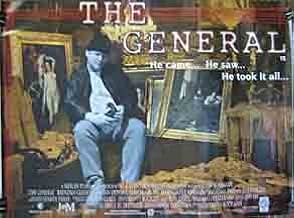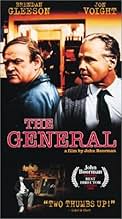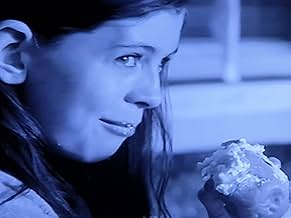Agrega una trama en tu idiomaThe real-life story of Dublin folk hero and criminal Martin Cahill, who pulled off two daring robberies in Ireland with his team, but attracted unwanted attention from the police, the I.R.A.... Leer todoThe real-life story of Dublin folk hero and criminal Martin Cahill, who pulled off two daring robberies in Ireland with his team, but attracted unwanted attention from the police, the I.R.A., the U.V.F., and members of his own team.The real-life story of Dublin folk hero and criminal Martin Cahill, who pulled off two daring robberies in Ireland with his team, but attracted unwanted attention from the police, the I.R.A., the U.V.F., and members of his own team.
- Dirección
- Guionistas
- Elenco
- Premios
- 10 premios ganados y 14 nominaciones en total
- Harry
- (as Vinnie Murphy)
- Orla
- (as Roxanna Williams)
- Dirección
- Guionistas
- Todo el elenco y el equipo
- Producción, taquilla y más en IMDbPro
Opiniones destacadas
It's anti-hero, Martin Cahill was Ireland's most infamous criminal of recent times - so much so that there has been four screen depictions of him (Ken Stott in The Vicious Circle, Kevin Spacey in Ordinary Decent Criminal, Pete Postlethwaite in When The Sky Falls and Brendan Gleeson in The General).
He was guilty of some of the country's most outrageous crimes and capable of real brutality - most notably, injuring a forensic scientist in a car bomb and literally nailing one of his gang members to the floor.
Add into the mix the fact that the film has a largely Irish cast deploying thick Dublin accents and that Boorman chose to shoot it in black and white and you have a movie which wasn't exactly going to jump out at international and especially, US audiences demanding to be loved.
The result is perhaps Boorman's finest work, certainly on a par with the wonderful 'Hope and Glory'.
The film is also by a furlong the best of the four movies depicting Cahill's life.
This is in large part due to the brilliant performance of Irish actor, Brendan Gleeson in the central role.
The Irish Depardieu not only physically transforms himself into Cahill but captures the rebellious spirit, the intelligence and the charm.
It would have been easy to depict Cahill as a monster.
However, Gleeson and Boorman treat their audience with respect, building up a character with shades of darkness and light.
On one hand, viewers are given an appreciation of how "The General" was able to command the love of two sisters, his children and the adulation of his criminal associates.
However, Boorman's film is certainly no love letter to Cahill. We also see his sadistic side as in the bombing of the forensic scientist's car and crucifixion of one of his gang members, his lack of consideration and compassion for the 100 workers laid off at a storeroom he has robbed, his cold bargaining with the sexually abused daughter of one of his gang members.
The supporting cast also put in fine performances too.
Jon Voight not only masters the rural Irish brogue of the Garda (police) inspector bedevilled by Cahill but also the attitudes. It is a tough but ultimately sympathetic performance of a cop dragged unwillingly into the gutter.
Maria Doyle Kennedy and Angeline Ball give charming performances as the sisters who were also the women in Cahill's rather unorthodox life, with Ciaran Fitzgerald also making a sympathetic son.
Adrian Dunbar, Sean McGinley and Eanna MacLiam all put in spirited performances as members of Cahill's gang. McGinley, in particular, creates another memorably seedy performance as Gary.
Special mention should also go to Pat Laffan as a brutish Garda sergeant.
With it's cracking script, Richie Buckley's musical score and the black and white camerawork, 'The General' is easily up there with the best of modern movies made in Ireland (certainly, up there with Neil Jordan's 'The Butcher Boy' and Alan Parker's 'The Commitments').
It is a must see - a film which demands cult status.
Not your typical A-List Hollywood crime melodrama, this movie is not for everyone, especially those looking for the typical Vin Diesel or Al Pacino crime flick. This is more like the Sopranos in the Irish slums. And, I recommend it highly for a Saturday night rental; just be forewarned that it is quite brutal and intense at times.
My one reservation about the film is the portrayal of the main character, Martin Cahill, whom I think is overly glamorised. I remember before Cahills death his exploits as I saw them in the newspapers and television, and from the many stories which circulated around Dublin at that time of his criminal activity. This was no latter day Robin Hood. He was an unusually successful thief, no doubt, but with none of the charitable spirit. He was also extremely cruel, at one time breaking into the home of a social welfare officer and torturing him for hours simply because he had refused Cahill welfare payments.
I would recommend people to see this film, but at all times remember that the man it portrays was no one to be admired, but an example of the most vile thugs that Ireland has had the shame to produce in recent years. But then they say, "The devil has the best tales".
¿Sabías que…?
- TriviaThe house of writer and director Sir John Boorman was robbed by the real-life Martin Cahill. Among other things, he stole a gold record that Boorman had on the wall (an award for the "Dueling Banjos" theme from Amarga pesadilla (1972)), which inspired Boorman to include that scene in the movie.
- ErroresSet in 1984, the background of the anti-drug march features a car with a license plate beginning with "96," indicating 1996.
- Citas
Garda: Hey Cahill! Which sister did you screw last night? Both?
Martin Cahill: Yours.
- Versiones alternativasHome video version is colorized.
Selecciones populares
- How long is The General?Con tecnología de Alexa
Detalles
- Fecha de lanzamiento
- Países de origen
- Sitio oficial
- Idioma
- También se conoce como
- Kod adı general
- Locaciones de filmación
- Productoras
- Ver más créditos de la compañía en IMDbPro
Taquilla
- Total en EE. UU. y Canadá
- USD 1,214,198
- Fin de semana de estreno en EE. UU. y Canadá
- USD 26,771
- 20 dic 1998
- Total a nivel mundial
- USD 1,214,198
- Tiempo de ejecución
- 2h 4min(124 min)
- Color
- Mezcla de sonido
- Relación de aspecto
- 2.39 : 1


































